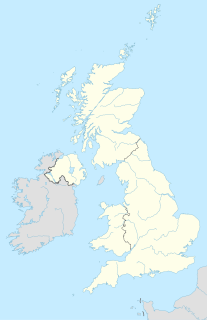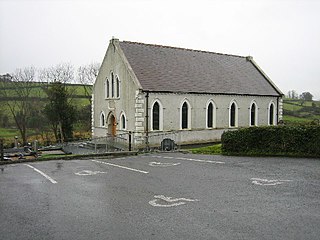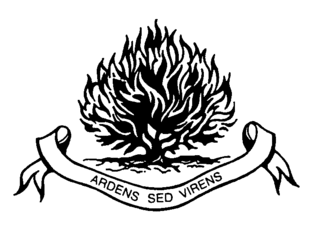
Dromineer is a small village and townland in County Tipperary, Ireland. It is situated on the shores of Lough Derg on the River Shannon. The village is located 10 km north of Nenagh on the R495 road. It is a civil parish in the historical barony of Ormond Lower. Historic documents describe the places as "Dromynnyre".

Devenish or Devinish is an island in Lower Lough Erne, County Fermanagh, Northern Ireland. Aligned roughly north–south, it is about one and a quarter miles long and two-thirds of a mile wide. The main place to catch a ferry to the island is at Trory Point, just outside Enniskillen. Devenish Island is owned by the Kilravock Christian Trust.
Donegore is the name of a hill, a townland, a small cluster of residences, and a civil parish in the historic barony of Antrim Upper, County Antrim, Northern Ireland. Donegore lies approximately 5 miles (8 km) east of Antrim town. 154 acres of the townland lies in the civil parish of Grange of Nilteen.

Derrygonnelly is a small village and townland in County Fermanagh, Northern Ireland. Near Lower Lough Erne, the village was home to 680 people and dates to the Plantation era. It is situated within Fermanagh and Omagh district.

Killinchy is a townland and small village in County Down, Northern Ireland. It is two miles inland from the western shores of Strangford Lough in the Borough of Ards and North Down. It is situated in the townland of the same name, the civil parish of Killinchy and the historic barony of Dufferin. It had a population of 539 people in the 2011 Census.

Lambeg is a small village and civil parish in County Antrim, Northern Ireland. Located between Belfast and Lisburn, it was once a small rural village, but is now within the Greater Belfast conurbation. Lambeg is also an electoral ward of Lisburn Council. In the 2001 Census it had a population of 60 people. The civil parish of Lambeg covers areas of County Down as well as County Antrim.

Lower Ballinderry is a small village to the west of Upper Ballinderry in County Antrim, Northern Ireland. It is within the townland and civil parish of Ballinderry and the historic barony of Massereene Upper. The village lies a short distance to the southeast of Portmore Lough and Lough Neagh, 12 km to the west of Lisburn. In the 2001 Census it had a population of 441 people.
Altmore ) is a hamlet and townland in County Tyrone, Northern Ireland. It is five miles from Carrickmore and four miles from Pomeroy. The townland is actually called Altmore and is situated in the historic barony of Dungannon Middle and the civil parish of Pomeroy and covers an area of 1117 acres.

Brackaville or Bracaville is a village and townland near Coalisland in County Tyrone, Northern Ireland. It is situated in the historic barony of Dungannon Middle and the civil parish of Donaghenry and covers an area of 235 acres on the western side of Lough Neagh.

Termon is a village and townland in the north of County Donegal, Ireland.

Carnteel ) is a hamlet, townland and civil parish, about 2 miles northeast of Aughnacloy in County Tyrone, Northern Ireland. It is situated in the historic barony of Dungannon Lower.

Tievenadarragh is a townland of 1,269 acres in County Down, Northern Ireland, at Loughinisland. It is situated in the civil parish of Loughinisland and the historic barony of Kinelarty.

Solar is a townland of 42 acres in County Antrim, Northern Ireland. It is situated in the civil parish of Carncastle and the historic barony of Glenarm Upper.
Aghamore is a townland which is located in the Civil Parish of Inishmacsaint, to the north-west of Derrygonnelly, County Fermanagh, Northern Ireland. The townland contains Carrick Church and graveyard, which are Scheduled Historic Monuments.

Ballydown is a townland of 529 acres in County Down, Northern Ireland. It is situated in the civil parish of Seapatrick and the historic barony of Iveagh Upper, Lower Half.

Tullynakill is a civil parish and townland in County Down, Northern Ireland. It is situated in the historic barony of Castlereagh Lower.

Clonrush or Clonmulsk is a civil parish in the barony of Leitrim in County Clare, Ireland. The largest settlement in the parish is Whitegate. In the Catholic Church, the parish is joined with Mountshannon.

Ardtole is a townland of 431 acres in County Down, Northern Ireland, near Ardglass. It is situated in the civil parish of Ardglass and the historic barony of Lecale Lower. The southern part of Ardtole townland is known as English Ardtole and the northern part is known as Irish Ardtole.

Blaris is a civil parish covering areas of both County Antrim and County Down, Northern Ireland. It is situated in the historic baronies of Castlereagh Upper and Iveagh Lower, Upper Half in County Down and Massereene Upper in County Antrim. It is also a townland of 543 acres, which contains the site of the Blaris medieval parish church, and is on the south-east side of the River Lagan, adjacent to Lisburn.






















